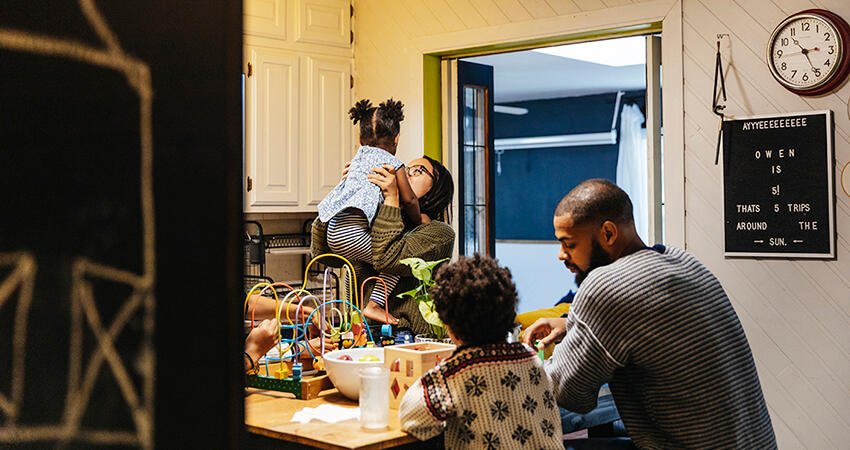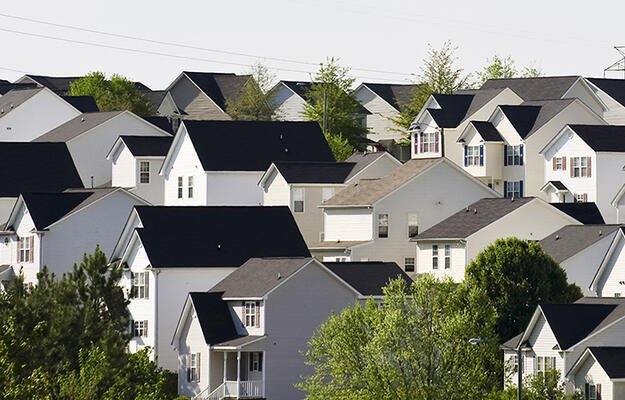
(The Good Brigade/Getty Images)
How Can We Advance Latino Homeownership and Housing Stability?
This post was originally published on Urban Wire, the blog of the Urban Institute.
Despite recent gains, Latino homeownership lagged 22 percentage points behind white homeownership in 2021.
Last year, the Federal Housing Finance Agency introduced Equitable Housing Finance Plans (EHFPs) to provide a road map for the government-sponsored enterprises to eliminate such housing market inequities. Freddie Mac’s original plan broadly included all households of color, while Fannie Mae’s focused on the Black Housing Journey (PDF) because Black homeowners face the widest homeownership gap and Black owners and renters have long faced unique barriers to obtaining stable housing.
This year, Fannie Mae’s updated EHFP includes a new Latino Housing Journey to reflect that this community, too, has been subject to racist, exclusionary, and extractive policies and institutions. The plan includes new data and identifies three stages of the Latino housing journey where common disparities exist.
The addition is timely; it comes at a moment when Latino households are poised to drive homeownership growth in the future. This National Homeownership Month, we are uplifting this new resource to highlight the inequities they face and to showcase solutions to eliminate barriers to equal access to homeownership for the Latino community.
Stage 1: Housing preparation
Research shows the following factors influence Latino households’ ability to enter the housing market:
- Language. The most recent American Community Survey data show that Latinos who speak only English or speak English very well had the highest homeownership rates. Research also shows that neighborhoods with higher rates of English proficiency tend to have higher homeownership rates than those with lower proficiency rates, even when controlling for other factors.
- Country of origin. The data also show that Latinos of Cuban origin had higher homeownership rates than those of Mexican, Puerto Rican, or other origins. These relationships are not necessarily causal, but more research should be done at the individual level to control for other factors and to understand the reasons for them.
- Immigration status. Research has found time living in the United States and citizenship status to be significant predictors of homeownership, though more scholarship that more directly studies these relationships should be encouraged.
- High proportion of multigenerational households. Latino households are larger and more multigenerational—nearly 10 percent more than their non-Latino counterparts in 2016. This means Latino households are more likely to need larger—and therefore more expensive—homes.
- Wealth and income gaps compared with white households. These gaps are the result of a long history of racial exclusion in the broader US economy (PDF) and severely limit many Latinos’ ability to afford a mortgage.
These factors show that the Latino population is not a monolith. Disaggregating Latino population data by unique demographic and socioeconomic characteristics can help policymakers understand the unique barriers different Latino households face—and then more effectively target solutions to help them enter the market. Such solutions could include distributing Spanish-language housing education materials in neighborhoods with high concentrations of residents with limited English proficiency or funding for housing counselors in ethnic enclaves with fewer resources.
Stage 2: Home or rental process
Latinos face unique obstacles in the underwriting and home search processes, including the following:
- Significantly higher mortgage denial rates than their white counterparts, with most denials being attributed to debt-to-income ratios or credit scores, according to the most recent Home Mortgage Disclosure Act data. Credit scores are not race neutral, as the financial instruments that back them have been less available to communities and people of color for decades.
- Higher likelihood than white households to be unbanked, have little or no relationships to financial institutions, no credit, or limited or no documented financial history, which makes qualifying for a mortgage more difficult.
- Uniquely high housing cost burdens because they are highly concentrated in high-cost markets such as California and New York.
- Discrimination, particularly toward Latino immigrants, such as being shown fewer housing units and steered toward lower-income neighborhoods by real estate agents (PDF).
Luckily, research shows several promising solutions can help address these disparities.
- Housing counseling programs. The more knowledge and resources a household has at the beginning of the housing journey, the more likely the household can either maintain homeownership or sustainably build toward homeownership through renting. Counseling programs help make Latino homebuyers fully aware of their financing options when preparing for purchase so that they aren’t paying more over the long term, and they help homebuyers identify options like special purpose credit programs or other targeted initiatives.
- Strengthening relationships with financial institutions. Latinos need relationships with financial institutions to buy homes, so policies that provide better resources to minority depository institutions, which specifically serve communities of color, could help reach more Latino borrowers. Urban Institute research has found that Black-owned banks help Black businesses, communities, and homebuyers, but more research can be done to understand the benefits and challenges for Latino-owned depository institutions.
- Improving credit scoring to include additional borrower metrics can increase credit visibility and scores for Latinos. Urban found that more Latino borrowers would likely be approved for loans if positive rental payment history was incorporated into mortgage underwriting. Fannie Mae’s Desktop Underwriter, its automated underwriting system, incorporates consumers’ rental payments in the mortgage credit evaluation process for first-time homebuyers, and Freddie Mac has a similar initiative to incorporate these data through third-party service providers.
Stage 3: Move-in, home maintenance, and preservation
Once they obtain homes, Latino households face the following challenges to maintaining stability and safety:
- Paying more to finance homes in the long term. Latino borrowers are more likely to have used alternative financing or high-cost financing in their home purchase. This financing gap is accentuated by the fact that Latino households are less likely than their white counterparts to take advantage of falling interest rates through refinancing (PDF) and have fewer liquid assets on average, which are a key factor in preventing mortgage default.
- Unique climate risks. Latino households and other households of color are less aware of flood risk and flood insurance, which is especially problematic because a disproportionately high share of the population residing in the combined floodplain is Latino.
Housing counseling programs can also support Latino homeowners and renters during this phase of the rental process. According to the US Department of Housing and Urban Development, households that receive post purchase counseling are nearly three times as likely (PDF) to receive a loan modification and have greater reductions in monthly payments and lower default rates for delinquent borrowers. Urban research offers concurring evidence that improvements to the loss mitigation framework to reduce reliance on falling mortgage rates can help ensure that Latino households do not lose their homes during periods of economic distress.
Looking forward
Many of the barriers that Latino households face at every step in the housing journey are the results of systemic racism. Fannie Mae’s new Latino Housing Journey offers data to unpack the disparities Latino households face and presents policy solutions that could increase Latinos’ homeownership capacity.
At a moment when Latino households are projected to drive much future homeownership growth, the EHFP lays a solid foundation, but more research is needed to better understand Latino households’ unique housing needs and improve their housing market access. Urban looks forward to engaging academics, researchers, organizations, and policymakers on further research and policy solutions to improve access to credit for future homebuyers of color.


